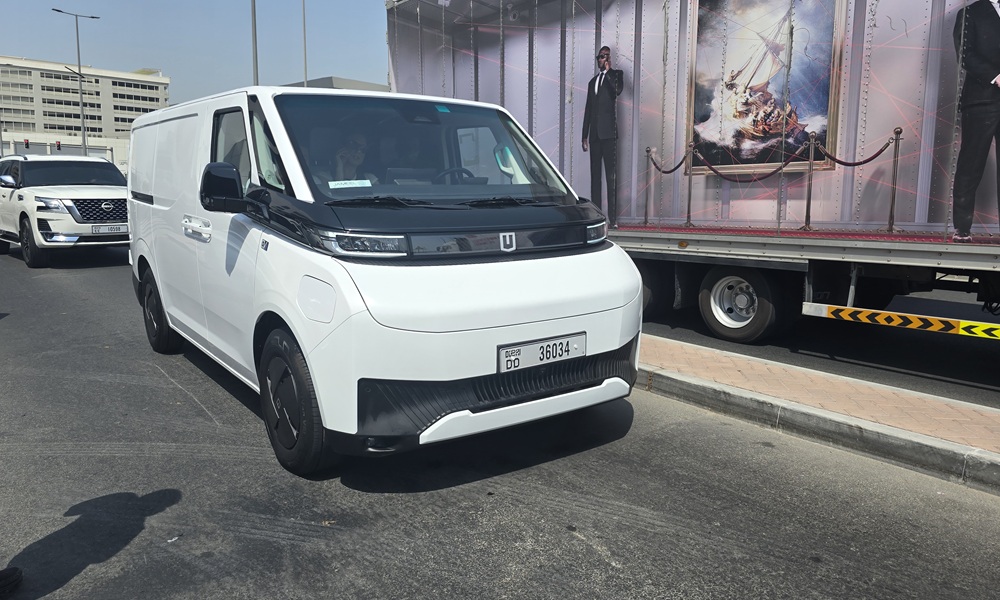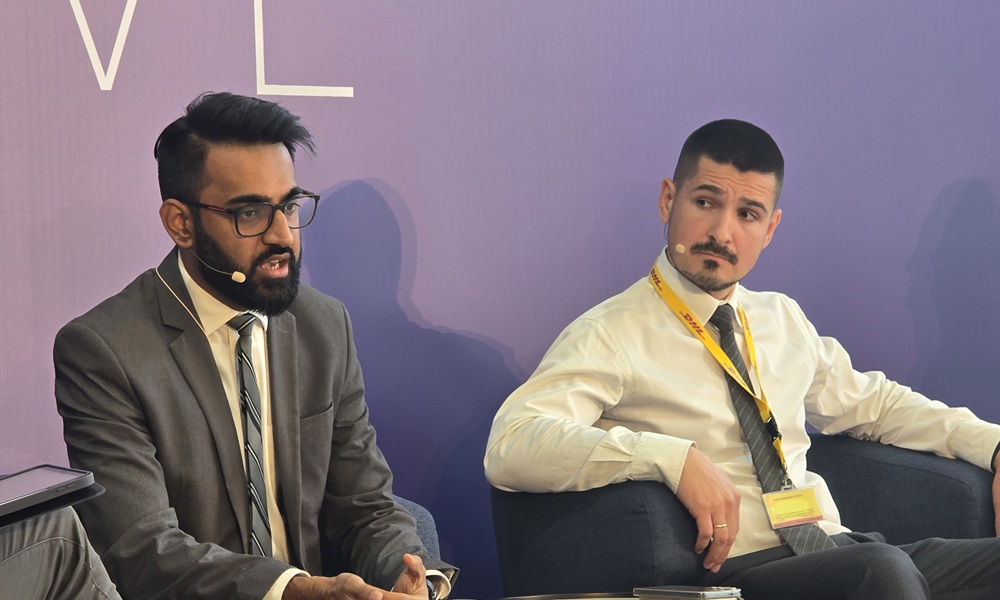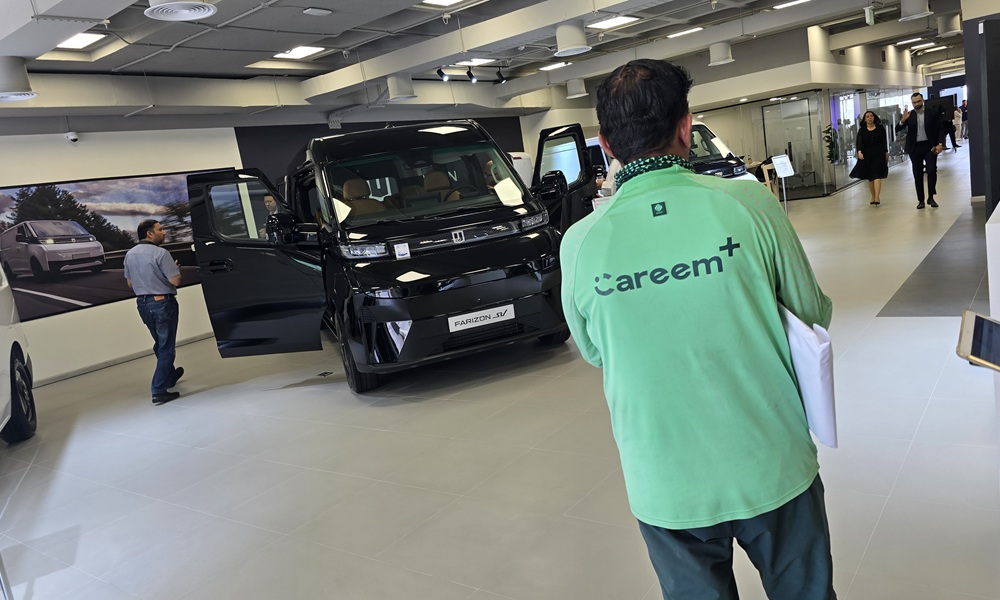The Chinese EV takeover of the electric commercial vehicles segment took another step forwards today as Jameel Motors and Farizon officially launched the Farizon SV, a new range of electric commercial vehicles designed to meet regional fleet and delivery demands.
During the Farizon SV launch, the conversation went far beyond the product features including in impressive array of safety features. It was an opportunity to reflect on the UAE’s journey toward cleaner, more efficient logistics — and the barriers that must be addressed before electric commercial vehicles (ECVs) can truly scale.
“Mobility is more about getting from A to B it is about creating opportinities on the road,” said Fady Jameel, Vice Chairman, Abdul Latif Jameel as he kickstarted the launch of the Farizon Auto van range in the UAE. “We are setting new standards. We want to be the platform of choice intetnationally for global brands.”
Joined by Abhishak Kaushal, Chief Logistics Specialist at the RTA; Sergey Shcherbakov, Senior Procurement Manager MENA at DHL; and Zeeshan Gaus, Head of Product at Jameel Motors, the event also gathered government, fleet operators, and OEMs in a single forum to dissect both opportunity and reality.
The Promise of Electrified Logistics
For Jameel Motors, the launch of the Farizon SV is both the arrival of a new brand in the market and the beginning of a complete electric mobility ecosystem for fleets from the company.
“We’re not merely introducing another electric van or truck,” explained Zeeshan Gaus. “We’re building an entire ecosystem — a network of products, lifecycle support, and customer partnerships designed for the way UAE logistics actually works.”
The Farizon range, comprising electric vans, light trucks, and tractor units, aims squarely at last-mile delivery, cold chain, and urban distribution — sectors seeing exponential growth from e-commerce and rapid grocery delivery. For today, the talk was centred on the Super Van in its cargo and passenger form.
“When you look at logistics, uptime is everything,” Gaus added. “Our vehicles are purpose-built — with chiller, freezer, and payload options — and supported by mobile service and strong aftersales coverage. We’re here to deliver reliability, not just sustainability.”
But Gaus was also candid about the current challenge: customers in the UAE want to go electric, yet many hesitate because the wider ecosystem — from charging to leasing to resale — remains underdeveloped.

The Government’s Role: Creating a Framework for Transition
The RTA’s Abhishak Kaushal reminded the audience that EVs still account for only a single-digit share of the UAE’s total commercial fleet. Globally, this number ranges from 25% to 40%, depending on the region.
Bridging that gap, he said, requires more than policy ambition — it needs coordination between regulators, investors, and operators.
“Our question is simple: how do we create an environment that accelerates adoption while maintaining financial sustainability?” Kaushal asked. “We can’t depend on incentives forever. Incentivisation has its purpose, but the goal is a self-sustaining market where electric vehicles are commercially viable without government support.”
He pointed to the RTA’s EcoFleet Programme, launched at WETEX 2025, as one key instrument. The initiative recognises and rewards companies according to the proportion of green vehicles in their fleets, ranking them Platinum, Gold, or Silver — a mechanism designed to nudge operators rather than mandate change.
“We’re inviting logistics companies to be part of the solution,” Kaushal said. “If you have a high percentage of electric or hybrid vehicles, you’ll receive tangible benefits and recognition. It’s about making sustainability competitive.”
Kaushal also referenced Dubai’s framework for autonomous logistics, which will allow companies to test and operate semi-autonomous electric trucks under controlled pilot conditions.
“It’s a first for the region,” he added. “Our goal is to set realistic regulations — not to over-prescribe. We want to give operators the trust and flexibility they need to invest.”
The Leasing Dilemma: Breaking the Vicious Circle
While incentives help kickstart demand, financing and residual value are where the ecosystem still falters. DHL’s Sergey Shcherbakov was blunt: electric adoption remains trapped in a cycle where cost of ownership, insurance rates, and infrastructure availability each depend on the other to mature first.
“Manufacturers often pass most of the resale risk to customers,” he explained. “Insurance companies are not yet convinced, so premiums are three to four times higher than for diesel. That raises TCO, making the shift harder to justify.”
“Insurance premiums remain three to four times higher than for diesel vehicles, and that keeps the TCO elevated.”
He outlined DHL’s own electrification target — 30% of its MENA fleet — and confirmed that the company’s pilot programmes have proven that today’s electric trucks can withstand the region’s climate and mileage demands.
“We’ve tested many brands under UAE conditions,” Shcherbakov said. “They’re stable, reliable, and deliver the daily range our operations require — 200 to 300 km. The technology is not the issue anymore. The issue is confidence — from financiers, lessors, and insurers.”
Despite cost challenges, Shcherbakov reported positive test results: the company’s trials with multiple EV brands confirmed performance stability even in UAE summer temperatures, with reduced noise and improved driver comfort thanks to advanced onboard safety and telematics system.
Kaushal agreed that residual-value guarantees and shared risk models could be critical. “We’re exploring whether OEMs and leasing firms can guarantee end-of-life values,” he suggested. “That would give partners more confidence to buy now rather than wait five years.”
Infrastructure: The Missing Link
All panellists converged on one point — the charging network must come first.
“In Europe, DHL builds its own charging infrastructure,” said Shcherbakov. “Here, if there’s a wide, reliable network developed through public-private partnerships, we won’t need to. That makes the investment decision far easier.”
Kaushal added that while battery-swapping stations are already operational in more than ten UAE locations, widespread charging infrastructure remains a major determinant of adoption.
“Until the network density increases, fleet operators will hesitate. It’s not a lack of will — it’s about operational practicality,” he said.
This infrastructure gap contributes to what he called the ‘soft market problem’: limited charging access discourages investment in EVs, which in turn delays the business case for more charging hubs. Breaking that cycle will require coordinated capital investment, regulatory flexibility, and stronger participation from private operators and investors.
Building a Self-Sustaining Ecosystem
For Jameel Motors and Farizon, the answer lies in integration. Beyond vehicle sales, Gaus highlighted leasing pilots, digital telematics, and aftersales support as enablers that reduce fleet downtime and improve confidence.
“Our goal is to act as a mobility engineer — not just a distributor,” he said. “We work directly with partners to tailor solutions that make financial and operational sense, from SMEs to national logistics players.”
He also pointed to the rapid rise of e-commerce and quick-commerce logistics, which is expected to push delivery volumes across the region to new highs. “The sector is growing by four to five percent annually,” Kaushal added, “and that growth curve makes the shift to electric both urgent and inevitable.”
The RTA has set a national emissions reduction target of 33% by 2030, with transport among the focus sectors. Achieving that will require shared commitment.
“Public investment alone isn’t enough,” Kaushal cautioned. “Private players — from vehicle suppliers to financiers — must step up and see this not as risk, but as opportunity.”
Confidence, Collaboration, and Critical Mass
If one theme defined the Farizon SV launch discussion, it was partnership. Every speaker agreed that the UAE is now entering a second, more mature stage of EV development — moving from symbolic early adoption toward industrial-scale transformation.
But to reach that stage, all stakeholders must collaborate to reduce uncertainty: building infrastructure, stabilising financing, and harmonising cross-border trucking regulations so electric fleets can operate regionally without friction.
As Shcherbakov put it, “When government, OEMs, and logistics operators share the same agenda, adoption will accelerate naturally. The first movers are already proving the technology works. Now it’s about making the economics work.”
Or, as Kaushal concluded: “We’ve already started the journey. The need for change — and the measures for change — are right now.”




